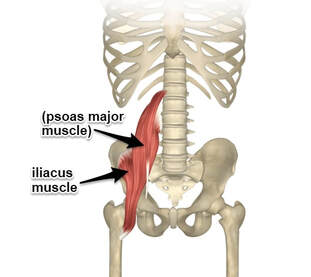 Severe low back is often due to psoas and iliacus muscles spasm. These muscles are often referred to as "hip flexors", however they also bend and rotate the spine. A spasm of these muscles can recruit other muscles into spasm such as the abdominal muscles. This type of spasm often occurs after an injury, after overworking the low back muscles and also after sitting for an extended period of time such as in a car or plane. Typically, a person with a psoas spasm will feel better while sitting, then when they arise from a chair they may need two or three steps before then can straighten to standing. Often a patient will have one side that is in spasm. These patients will either be flexed laterally or have their shoulders quite dramatically off to one side in relation to where their hips are. About 60% of severe low back pain that I see in my Chiropractic office is due to low back muscle spasm. The psoas muscle is attached to the front of the vertebra and discs and can pull them out of place causing severe pain. A low back spasm can become chronic, so it is important to relax the muscle then improve core strength. Psoas and Iliopsoas Muscle Spasm Home Protocol 1.) Avoid Sitting especially long drives in car or on plane - If you must, don't drive and lean passenger car seat back as far as possible. 2.) Avoid walking long distances except around the house 3.) Wear a back brace if it helps 4.) Stretch Hip Flexor Muscles: Leg off side of bed, remember to bend opposite knee to protect/flatten low back curve. 5.) Do these Home Exercises to Align Your Sacroiliac Joints (2-3 x per day) to your comfort level. 6.) Gentle Core Exercises (2-3 x per day
8.) Heat on Low Back and/or Lower Abdomen:
10.) Try Muscle Relaxers:
-- Kelley LeBlanc, D.C. Kelley Chiropractic and Wellness Village at Wexford 1000 William Hilton Pkwy, Ste K100 Hilton Head Island, SC 29928 (843) 321-8119
0 Comments
If your pain is in buttocks and back of thigh, but does not go below the knee you may have Piriformis Syndrome. This happens when the piriformis muscle (one of the major buttocks muscles) presses on the sciatic nerve. Piriformis syndrome can be caused by the piriformis muscle being
a.) Too tight OR b.) Overstretched OR c.) Sprain/strained 1.) Reduce inflammation
2.) Gently Stretch
3.) Strengthen
4.) Balance Exercises
The above assumes piriformis muscle pressure on the sciatic nerve. Here are other common issues that could be causing sciatic-like pain.
Kelley LeBlanc, D.C. Kelley Chiropractic and Wellness Village at Wexford 1000 William Hilton Pkwy, Ste K100 Hilton Head Island, SC 29928 (843) 321-8119 4/20/2020 2 Comments Home Care Protocol for SciaticaSciatica: What is it and how is it treated? via Web MD
If you have 10/10 low back and or leg pain you may want to visit Moss Creek Orthopedic Urgent Care, (843) 836-7022 for an MRI, steroid injection, muscle relaxers and/or pain medication. Home Care Protocol for Sciatica: 1.) Avoid Sitting. Laying on your back removes pressure on the lumbar disc, standing is somewhere between. 2.) Don't lift more than 5 lbs. When you cough or sneeze, support yourself by holding a pillow on your stomach. 3.) Reduce inflammation and feed the disc
4.) Do NOT use heat on the low back. It might feel good, but it can exacerbate inflammation, making you worse. 5.) If you have very acute low back pain 9-10/10 try this: Extreme Low Back Pain, Sciatica, Disc Herniation - Gentle Traction 2 - 3x per day or more 6.) If you can do #5 with ease try this: Gentle Knee to Chest Stretches for Low Back Arthritis 2 - 3 x per day or more 7.) If you can do #6 with ease try this for 10 minutes, 2 - 3 x per day or more: Lay with your back on a (cushioned) floor with your feet over an ottoman. 8.) If you can do # 7 with ease try this 10 minutes, 2 - 3 x per day or more: Lay on your back with your feet up the wall...You do NOT need to straighten your legs on the wall. #7 and #8 - These stretches gently traction the low back and send fresh healing blood to the area of injury. They are very simple but highly effective. There is no upper limit on how long you can stay in this position, but stay for at least 10 minutes 2-3x/day. 9.) If your sciatica is caused by a disc injury, you might feel better before the disc is healed. Remember reinjuring an already injured disc can get you into real trouble. A disc that might have healed in a few weeks could be reinjured and could take 6 months to a year to recover. The above assumes a disc injury. Here are other common issues that could be causing sciatic-like pain.
Kelley LeBlanc, D.C. Kelley Chiropractic and Wellness Village at Wexford 1000 William Hilton Pkwy, Ste K100 Hilton Head Island, SC 29928 (843) 321-8119 |
Archives
September 2022
CategoriesAll Activator Allergy Anxiety Applied Kinesiology Autoimmune Disease Back Pain Back Spasm Blood Pressure Breastfeeding Bunions Cancer Cancer And Sprit Chiro Saves Money Depression Disc Disease Energy Work Flu Foot Pain Green Smoothies Gut Health Healthy Boundaries Heart Disease Hip Flexor Home Care Hormone Disruptors Immune Strength Juicing Kidney Liver Love Neck Pain Newborn Nutrition Piriformis Syndrome Posture Protein And Diet Psoas Reiki Scar Reduction Sciatica Second Career Skincare Sleep Spinal Arthritis Stand Up Desks Stress Stroke Traction Types Of Stress Yoga Sandals |
